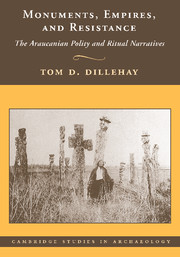Book contents
- Frontmatter
- Contents
- Figures
- Preface
- INTRODUCTION
- PART ONE PROSPECTS AND PATTERNS
- ONE PURPOSES, SETTINGS, AND DEFINITIONS
- TWO SHAPING ANALOGICAL AND CONCEPTUAL PERSPECTIVES
- THREE ARAUCANIAN PREHISTORY AND HISTORY: OLD BIASES AND NEW VIEWS
- FOUR IMBRICATING SOCIAL, MATERIAL, METAPHORICAL, AND SPIRITUAL WORLDS
- FIVE THE ETHNOGRAPHIES OF KUEL, NARRATIVES, AND COMMUNITIES
- SIX AN ARCHAEOLOGICAL VIEW OF KUEL AND REHUEKUEL
- PART TWO ANALYSIS AND INTERPRETATION
- Appendix One Ethnographic Ritual Narratives at Hualonkokuel and Trentrenkuel
- Appendix Two Radiocarbon Dates and Thermoluminescence Dates
- References Cited
- Index
FOUR - IMBRICATING SOCIAL, MATERIAL, METAPHORICAL, AND SPIRITUAL WORLDS
Published online by Cambridge University Press: 27 July 2009
- Frontmatter
- Contents
- Figures
- Preface
- INTRODUCTION
- PART ONE PROSPECTS AND PATTERNS
- ONE PURPOSES, SETTINGS, AND DEFINITIONS
- TWO SHAPING ANALOGICAL AND CONCEPTUAL PERSPECTIVES
- THREE ARAUCANIAN PREHISTORY AND HISTORY: OLD BIASES AND NEW VIEWS
- FOUR IMBRICATING SOCIAL, MATERIAL, METAPHORICAL, AND SPIRITUAL WORLDS
- FIVE THE ETHNOGRAPHIES OF KUEL, NARRATIVES, AND COMMUNITIES
- SIX AN ARCHAEOLOGICAL VIEW OF KUEL AND REHUEKUEL
- PART TWO ANALYSIS AND INTERPRETATION
- Appendix One Ethnographic Ritual Narratives at Hualonkokuel and Trentrenkuel
- Appendix Two Radiocarbon Dates and Thermoluminescence Dates
- References Cited
- Index
Summary
Although the Araucanians were relatively conservative and materially inconspicuous until the Spanish conquest, they suddenly were thrust into a new world of awareness in the mid-1500s – one of survival. They rapidly became aware of the need for a new societal organization and a new built landscape to resist Spanish invasion. In some areas, this need was partly engendered by the frequency and repetition of mound building and by the public ceremonies, larger agricultural communities, and institutions that accompanied these acts. Today, memories and knowledge of these events saturate the landscape; they are inscribed spatially on the land in the architectural ideology of kuel and rehuekuel and in the names that have become historic and lived places. Memories also record the successes of dynastic patrilineages and the fragmented populations who moved in, the occupations that they practiced, the activities they pursued, and the roles they played in reconstituted settings. Thus, like the landscape as a whole, kuel and rehuekuel represent geographically reconstituted social meanings, genealogies, memories, compatriotism, and shared political identities.
Yet, the landscape is more than just identities and memorial places that define and are defined by history. It also is a network of bounded pathways of social interaction defined by the movement of people between and practices at the locations of these places and of the sacred mountains and hills, nguillatun fields, and residential sites. All of these elements serve as reference nodes in time and in space (see Chapters 5 and 6).
- Type
- Chapter
- Information
- Monuments, Empires, and ResistanceThe Araucanian Polity and Ritual Narratives, pp. 153 - 215Publisher: Cambridge University PressPrint publication year: 2007



